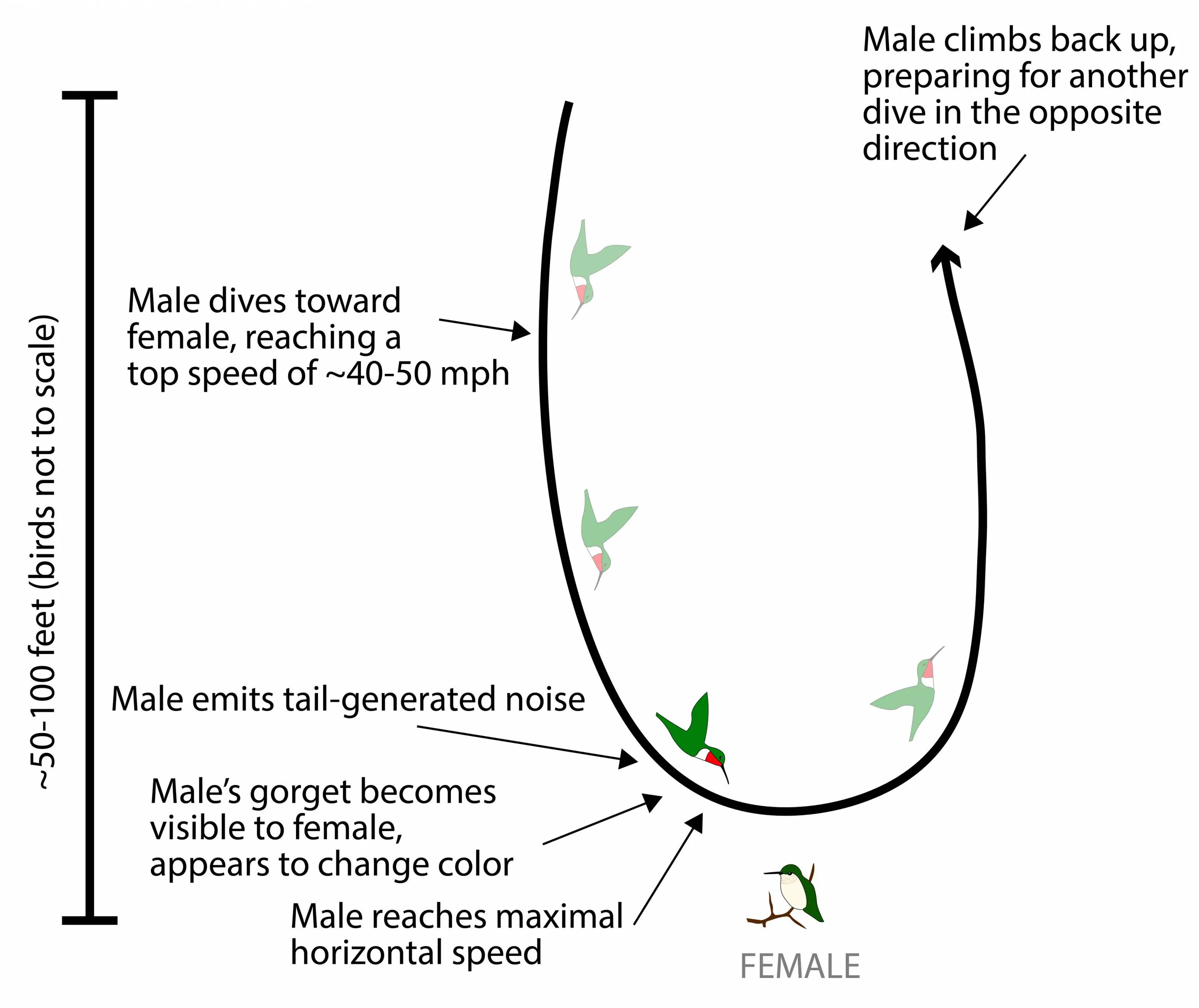Animal courtship is a fascinating display of nature’s artistry, with males across the animal kingdom employing elaborate behaviors to attract females. While peacocks flaunt their iridescent tails and manakins perform intricate dances, hummingbirds engage in equally spectacular courtship rituals. Among these aerial acrobats, the male broad-tailed hummingbird (Selasphorus platycercus) executes breathtaking dives, plummeting from heights of up to 100 feet before ascending and diving again in a mesmerizing aerial ballet. Researchers at Princeton University, studying a population of these hummingbirds in Gothic, Colorado, have delved into the intricate ways these birds combine speed, sound, and color in their courtship displays, revealing a complex, multi-sensory performance.
The Art of the Hummingbird Dive
The courtship dives of hummingbirds are truly remarkable feats, especially considering the diminutive size of these birds. As Benedict Hogan, the study’s lead author and a postdoctoral research associate in ecology and evolutionary biology, explains, these dives are characterized by impressive speeds. “We know from previous work that the males can reach really high speeds,” Hogan notes. “They combine that speed with intriguing noises generated by their wing and tail feathers, and of course with their brightly iridescent plumage.” The critical question for biologists, however, is how these distinct elements coalesce and what the experience of such a dive might be like for a female hummingbird.
 A male broad-tailed hummingbird in flight
A male broad-tailed hummingbird in flight
A male broad-tailed hummingbird, like the one pictured, utilizes its iridescent throat feathers and produces a buzzing sound during its synchronized courtship dive. These hummingbirds are native to Central America and spend their summers in the western United States.
To unravel this complex interplay, a team of Princeton biologists meticulously recorded the dives of 48 wild male broad-tailed hummingbirds. Utilizing image-tracking software, they were able to map each male’s trajectory and speed throughout its dive. By integrating this spatial data with audio recordings, the researchers precisely identified the moments when the males produced a distinct mechanical “buzz” generated by their tail feathers.
Decoding the Visual Spectacle
Capturing the nuances of iridescent plumage color from video recordings proved challenging. To overcome this, the research team visited the American Museum of Natural History in New York City. Employing a multi-angle imaging technique and a specialized ultraviolet-sensitive camera, they photographed specimens of broad-tailed hummingbirds. Since hummingbirds possess tetrachromatic vision—meaning their eyes have four color cones, including one sensitive to ultraviolet wavelengths—the researchers combined these photographs with a model of hummingbird color perception and the characteristic U-shaped flight path of the dive. This comprehensive approach allowed them to estimate the male’s iridescent throat feathers from a female’s perspective.
 A male broad-tailed hummingbird flies upward
A male broad-tailed hummingbird flies upward
A male broad-tailed hummingbird ascends on the final segment of its U-shaped dive, passing by a potential mate.
The Climax of the Courtship Dive
By synthesizing all the gathered data, Hogan and senior author Mary Caswell Stoddard, an assistant professor of ecology and evolutionary biology, were able to reconstruct the precise sequence of events during a hummingbird’s courtship dive. “We discovered that the most dramatic aspects of the dive — high speed, the mechanical buzz and a rapid iridescent color change — happen almost all at once, just before the male soars past the female,” stated Stoddard. “These aerial acrobats deliver an in-your-face sensory explosion.”
The sequence begins with the male initiating the tail-feather buzz. Concurrently, his vibrant red throat feathers become visible to the female, and due to his rapid movement and changing orientation, they appear to quickly shift to black. It is during this intense, short-lived moment that the male achieves his maximum horizontal speed. The researchers posit that due to the male’s high velocity, a female would perceive a shift in pitch—first upward, then downward—as he approaches and then departs, a phenomenon known as the Doppler effect. This effect is analogous to the change in pitch heard from a car horn as a vehicle passes by.
All these critical courtship elements—peak speed, the tail buzz, and the dramatic color change—unfold within an astonishingly brief 300-millisecond window, comparable to the duration of a human blink.
The Significance of Timing
The precise importance of this tightly synchronized timing for female hummingbirds remains an area for further investigation. However, the researchers hypothesize that these meticulously coordinated maneuvers may convey information about the male’s physical condition or appeal to a female’s aesthetic preferences. The study underscores the crucial role of timing and motion in understanding animal courtship signals.
“In the real world, many animals strut their stuff in complex, dynamic ways,” commented Stoddard. “Whether it’s a diving hummingbird or a dancing peacock spider, we need to account for motion and orientation to understand how these remarkable displays evolved.”
 Illustration of the flight pattern and courtship rituals of hummingbirds
Illustration of the flight pattern and courtship rituals of hummingbirds
Male broad-tailed hummingbirds meticulously synchronize key events—maximal horizontal speed, the loud buzz produced by their tail feathers, and the display of their iridescent throat patch (gorget)—within a mere 300 milliseconds, or about the time it takes to blink.
The research, titled “Synchronization of speed, sound and iridescent color in a hummingbird aerial courtship dive,” was published in the journal Nature Communications and was supported by the Princeton Environmental Institute’s Climate and Energy Grand Challenges Program and a Sloan Research Fellowship awarded to Stoddard.
